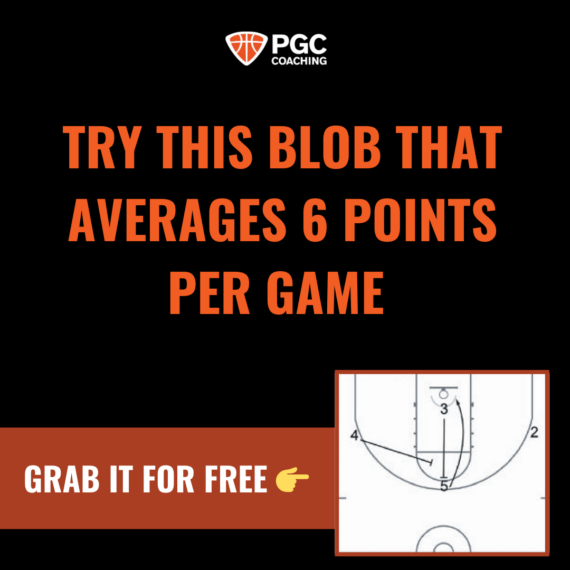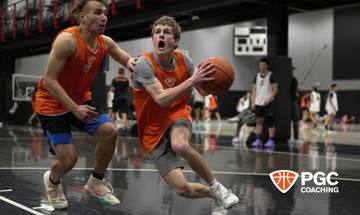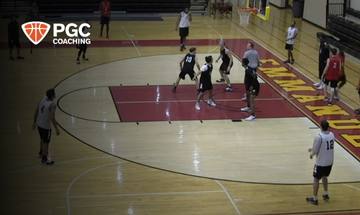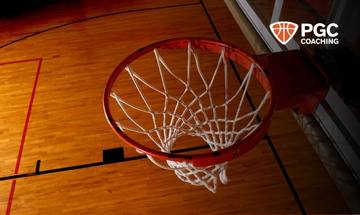How to Teach On-Ball Defense That Actually Works in Games
Every coach wants defenders who can stay in front of the ball, but most players struggle with it—not because they can’t do it, but because they’ve never been taught how.
At PGC, we break on-ball defense into a few teachable, repeatable habits. If you like the following tips, you may also like these additional defense resources…
- Smarter Closeouts: How to Defend Shooters, Drivers, and Complete Players
- How to Train Help Defenders to Win 2-on-1 Situations
- 45 Scramble Down: Build Communication, Rotations, and Recovery in One High-Impact Drill
And if you want defenders who can sit down and slide, it starts with teaching the right cues and building them into every rep.
Here’s how you do it and what to teach your players…
1. Start with the Stick Hand
The first job of a great on-ball defender is to eliminate easy shots. A “stick hand” means one hand high above the ball—active and ready to contest. It doesn’t just take away the jumper; it creates a psychological presence. That one cue alone often gets shooters second-guessing.
2. Bounce Before the Bounce
The moment an offensive player starts to move, teach your defenders to “bounce before the bounce.” This simply means getting light on their feet, in their stance, and ready to move as the dribble starts—not after.
It helps players stay balanced and prepares them to slide or retreat effectively.
3. Guard Your Yard
We define success on-ball as winning the first two dribbles. We call it “guarding your yard”—roughly a six-foot box in front of the defender. If your player can win those first two dribbles, they’ll put themselves (and your team) in position to help or recover. That’s team defense starting with individual accountability.
4. Build Reactionary Gap Discipline
Not every player is the fastest. That’s okay… but only if they know how to position themselves.
Train your players to create a “reactionary gap,” giving them just enough space to read and respond without conceding driving angles. This habit gives your defenders confidence, even against quicker opponents.
5. Never Stop the Play
One of the biggest habits we build is playing through the next action.
Defense doesn’t end after one slide. If the ball’s passed, jump to the ball. If your player picks it up, close the space. We train defenders to think in chains, not single actions.
You don’t need the most athletic players to be a great defensive team—but you do need disciplined ones. Start teaching the stick hand, bounce timing, and reactionary gap, and you’ll start seeing better on-ball defense… and fewer blow-bys.
Watch the On-Ball Defense Drill Video
More of a visual learner? Or better yet, want to share this with your staff? See the On-Ball Defense Habits Drill in action.
FAQ: Teaching On-Ball Defense That Sticks – Coaching Cues, Habits, and Game-Ready Principles
These FAQs help coaches implement the On-Ball Defense Habits drill and teach defense in a way that players can apply in real game situations.
Q: What is the stick hand in on-ball defense?
A: The stick hand is a high, active hand that defends the shot and disrupts vision. It trains players to:
- Contest without fouling
- Take away rhythm jumpers
- Apply psychological pressure early
It’s a simple cue that builds a powerful defensive habit.
Make “stick hand” a constant coaching cue in every closeout or 1-on-1 rep.
Q: What does “bounce before the bounce” mean?
A: It’s a cue to get light on the feet just before the offensive player dribbles. Instead of reacting late, players:
- Stay in a loaded stance
- Time their movement to match the ball
- Prepare to slide or absorb contact
This teaches anticipation instead of reaction.
Drill this into warm-ups and breakdown reps to create defensive timing.
Q: How do I teach players to “guard their yard”?
A: “Guard your yard” means defending the first two dribbles—roughly a 6-foot zone in front of the defender. It builds:
- Positional pride
- Accountability
- Awareness of help responsibility
It’s about teaching containment before relying on rotations.
Use cones or markers to define this area and let players compete to defend it.
Q: What is a reactionary gap?
A: A reactionary gap is the space between the defender and the ball handler that allows for:
- Reading first movement
- Reacting without overcommitting
- Protecting against blow-bys
It’s essential for defenders who may not have elite speed but can win with angles.
Teach players to adjust their gap based on scouting reports and player tendencies.
Q: How do I build on-ball defense in less athletic players?
A: You don’t need elite athleticism to play great on-ball defense. Instead, focus on:
- Stick hand discipline
- Anticipation (bounce before the bounce)
- Positioning (reactionary gap)
- Competing to guard the yard
These teachable habits make any player more effective defensively.
Drill discipline over flash—defense is more about habits than highlights.
Q: Why do you emphasize “never stop the play” on defense?
A: Too many players defend the first action and relax. We train players to:
- Jump to the ball on passes
- Close space when the dribble picks up
- Recover and rotate with urgency
It’s a mindset shift from static defense to chain reactions.
Coach defense in sequences—build habits that link to the next play, not just the first.
Q: What are the biggest mistakes players make in on-ball defense?
A: Common errors include:
- Standing too upright
- Reacting after the dribble starts
- Giving too much space (or not enough)
- Stopping after one movement
Fix these with clear cues and high-rep breakdowns.
Use film and live drills to diagnose and address these habits weekly.
Q: How can I incorporate these on-ball defense habits into practice?
A: Use short, high-rep breakdowns like:
- 1-on-1 from wing or slot with a scoring limit
- Mirror footwork drills with stick hand emphasis
- Live play with a “guard your yard” constraint
Then build those reps into competitive 2-on-2 or 3-on-3 formats.
Start with habit drills, then apply in live game-speed settings for best transfer.
Q: Where can I find more defensive drills and breakdowns like this?
A: Explore more defensive teaching tools, breakdown drills, and cue-based training strategies inside the PGC Coaching Community. You’ll find:
- Habit-forming defensive frameworks
- Progressions from warm-ups to live play
- Video examples and coaching resources
Start with a free 7-day trial to access it all. Join the PGC Coaching Community to elevate your team’s defense with proven drills and cues like these.
Build Better On-Ball Defenders with Habits, Not Hype
Elite defense starts with positioning, anticipation, and discipline. The On-Ball Defense Habits drill teaches all three—so your team can compete, contain, and win possessions consistently.
Want more drills and tips just like these? Get FREE instant access to every defensive drill, tactic, and strategy we’ve ever created for 7 days.
– TJ
Check out all of our defensive drills and strategy resources here.
About the Author
TJ Rosene
Coach TJ Rosene, head coach of the Emmanuel University men’s basketball team and Director of Coach Development for PGC Coaching, has spent his career shaping young athletes both on and off the court. With over 400 career wins and 12 seasons of 20+ wins, Rosene’s coaching experience is extensive and impressive. His teams have competed in six national championship games, winning three NCCAA National Championships. Under his leadership, the Lions made their NCAA Division II debut in 2018-19 and quickly captured two season titles and one tournament title, along with an appearance in the NCAA Division II Sweet 16 in 2021.
Rosene’s success expands far beyond the scoreboard. He’s been named National Coach of the Year three times and Conference Carolinas Coach of the Year twice. But for Coach Rosene, the most meaningful part of his work is the lasting impact he has on his players’ lives. As he puts it, “Coaching is a rare opportunity to shape and mold the lives of young people. It’s a privilege that I never take for granted.”
New Here?
Get coaching tips and tools like these delivered to your inbox each week!
Join the 15,000 coaches we’ve assisted…

Related Articles
45 Scramble Down: Build Defensive Communication, Rotations, & Recovery in One High-Impact Drill
Master defensive chaos with the 45 Scramble Down Drill — boost your team’s communication, quick rotations, and clutch stops under pressure. Ready to take your defense to the next level?
Competitive 4-on-4 Basketball Drill to Build Decision-Making, Shot Selection, & Defensive Grit
Train like you play. This 4-on-4 drill builds real-game toughness, smart decisions, and winning habits—every possession counts.
Rodman Rebound Drill for Basketball: Build Toughness & One-Handed Rebounding Skills
Dominate the boards! The Rodman Drill trains players to fight through chaos, grab tough rebounds, and finish strong — building confidence and toughness for real games.
About PGC
PGC Basketball provides intense, no-nonsense basketball training for players and coaches. Our basketball camps are designed to teach players of all positions to play smart basketball, be coaches on the court, and be leaders in practices, games and in everyday life.
We combine our unique PGC culture with a variety of teaching methods and learning environments to maximize the learning potential of those that attend our sessions. In addition to spending 6-7 hours on the court each day, lessons will be reinforced through classroom sessions and video analysis.
Our goal at PGC is to empower you with the tools to fulfill your basketball dreams, while also assisting you in experiencing the joy of the journey.
To learn more about PGC Basketball, including additional basketball training tips and videos, visit our YouTube Channel or find us on Facebook, Instagram, and Twitter.




Share This Post